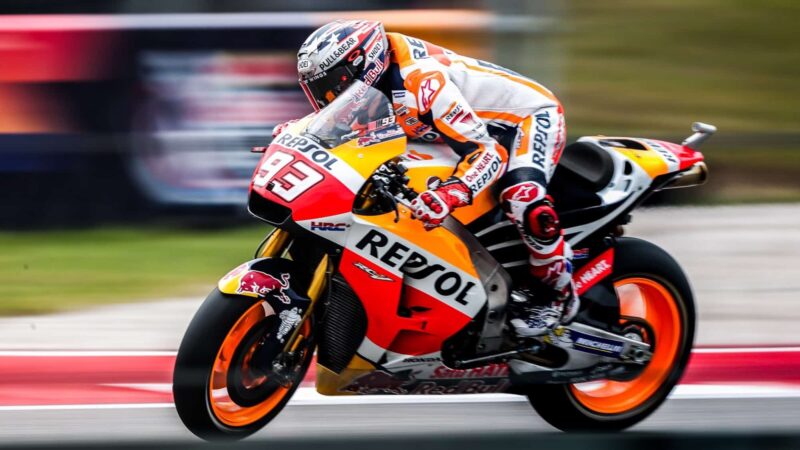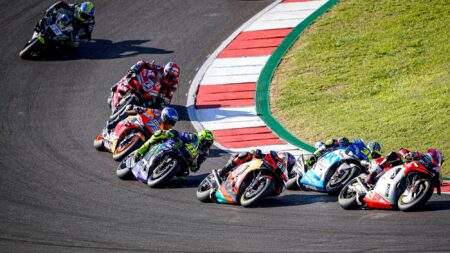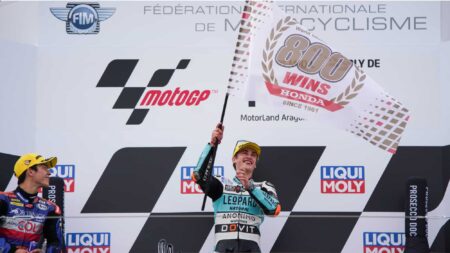Some fans hated saying goodbye to the 500s, others were delighted by the arrival of the roaring 990s, which had the added bonus of stealing some thunder from World Superbikes. During the 1990s WSB had grown in popularity while fans had drifted away from GPs, bored of waking up on race day wondering who would finish second to Mick Doohan. Of course, at that time MotoGP rights-holder Dorna didn’t own WSB.
Since the start of the 2002 MotoGP season there have been 329 races, with two clear winners: Valentino Rossi is the most successful rider of the four-stroke era, with 76 victories, while Honda is far and away the most successful manufacturer, with 153 race wins.
Thus far 29 different riders have won MotoGP races, with the three most successful – Rossi, Marc Márquez and Jorge Lorenzo – accounting for more than half those victories, which confirms the Italian and two Spaniards as the stand-out performers of the last two decades.
And only two or three of the top ten winners are still racing, which confirms that MotoGP is entering a new era. That new era started last season when there were five first-time winners, something which had never happened before in the premier class.
MotoGP rider victories 2002-2020:
| Rider(s) | Wins |
| Valentino Rossi | 76 |
| Marc Márquez | 56 |
| Jorge Lorenzo | 47 |
| Casey Stoner | 38 |
| Dani Pedrosa | 31 |
| Andrea Dovizioso | 15 |
| Sete Gibernau and Maverick Viñales | 8 |
| Loris Capirossi | 7 |
| Max Biaggi and Marco Melandri | 5 |
| Cal Crutchlow, Franco Morbidelli, Alex Barros, Nicky Hayden, Fabio Quartararo and Álex Rins | 3 |
| Miguel Oliveira, Danilo Petrucci and Makoto Tamada | 2 |
| Troy Bayliss, Brad Binder, Toni Elias, Andrea Iannone, Jack Miller, Joan Mir, Ben Spies, Chris Vermeulen and Tohru Ukawa | 1 |

Ride it cowboy! When will Marc Marquez be able to do this again?
Honda
Rossi is the only winner whose success spans all three four-stroke MotoGP engine eras – 990cc, 800cc and 1000cc. He’s also one of only six riders to have won races with more than one manufacturer: Honda and Yamaha. The others are Biaggi (Yamaha and Honda), Dovizioso (Honda and Ducati), Lorenzo (Yamaha and Ducati), Stoner (Ducati and Honda) and Viñales (Suzuki and Yamaha).
Honda leads the manufacturer charge by a wide margin, despite failing to win a race last year, the first time that’s happened in the four-stroke MotoGP era.
MotoGP manufacturer victories 2002-2020:
| Manufacturer | Wins |
| Honda | 153 |
| Yamaha | 115 |
| Ducati | 51 |
| Suzuki | 6 |
| KTM | 3 |
MotoGP has run under three different engine capacity limits since 2002: 990cc from 2002 to 2006, 800cc from 2007 to 2011 and 1000cc from 2012. Honda’s most successful machine is the 1000cc RC213V, which has won 81 races over the past nine years, while its least successful is the 800cc RC212V, which won 24 races in five years. The legendary V5 won twice that number during its five-year term.
Since the start of the four-stroke MotoGP era technical regulations have run under five-year segments. The 990s were got rid of due to concerns over speed and horsepower, following the death of Daijiro Kato at Suzuka in 2003, and the unloved 800s were dumped after five years because their low-torque engines had created one-line racing that gave us some of the most boring grand prix races in living memory.




